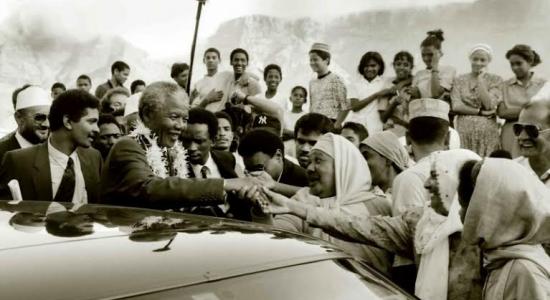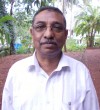Mandela and Islam in South Africa
 Lots of Muslim friends accompanied Mandela in his long walk to freedom. Ahmed Mohamed Kathrada, Ismail meer, Yusuf Dadoo, Fatima Meer, Amina Cachaliya, Rahima Moosa, Ibrahim Rasool, Imam Hassan Solomon are some of them, the last two holding high official posts later. Imam Abdullah Haroon embraced martyrdom in the dungeon of Apartheid in 1969; Ibrahim Rasool, Omar Abdulla, Ahmed Kasim, Ahmed Kathrada were co-prisoners of Mandela; Dr. Rashid Torir was killed during the struggle and some, like Yusuf Dadoo and Molvi Kachalia, were sent into exile.
Lots of Muslim friends accompanied Mandela in his long walk to freedom. Ahmed Mohamed Kathrada, Ismail meer, Yusuf Dadoo, Fatima Meer, Amina Cachaliya, Rahima Moosa, Ibrahim Rasool, Imam Hassan Solomon are some of them, the last two holding high official posts later. Imam Abdullah Haroon embraced martyrdom in the dungeon of Apartheid in 1969; Ibrahim Rasool, Omar Abdulla, Ahmed Kasim, Ahmed Kathrada were co-prisoners of Mandela; Dr. Rashid Torir was killed during the struggle and some, like Yusuf Dadoo and Molvi Kachalia, were sent into exile.
Mandela held out his hands of cordiality to Muslims and Islam. For them, just as for the Blacks in South Africa, he was Madiba and Tata (father). He extended generous support to the anti-colonial struggles in various Muslim lands, especially to the Palestinian resistance against Israel. He participated in the training camps of the National Liberation Front of Algeria. That is why some French writers had labeled him as a terrorist.
His fellowship with Muslims did not just come out of their participation in the anti-apartheid struggles with him. He recognized the liberation potential of Islam. Historically, South Africa stood witness to the fact that Islam as a faith goes in conjunction with the desire and struggle for freedom. One of the early generations of South African Muslims was that of slaves transported by the Dutch Colonialists from Indonesia. The Dutch were then, in a back handed manner, setting the stage for the Muslim community to grow. Though the immigrants, in course of time, came to forget their national culture and language -though somecolloquial expressions borrowed from their mother tongue like Lab Rang (Eid), Nameeraj (hosting), Kabraj (wooden slippers) and Karamath (tomb)-are preserved in their dialect- they did not lose their faith. They stuck to it as if it is a solid rock.
Another generation of Muslims who settled in South Africa includes Indians, whose immigration took place when both the countries were under the British rule. Initially they centered on Johannesburg and Durban to later spread all across the country. Later on, natives embraced Islam in large numbers. This led to the hybridization of different races among the Muslims in South Africa.
There were many incidents of confrontation between the Muslims and the apartheid administration. The administration attempted to appropriate mosques and Muslim religious centres. Muslims were reluctant to either forfeit their rights over them or sell them. Since those properties were entitled as waqf (property of God), the Muslims were ready to wage jihad against the administration for their protection. They still remain as monuments attesting to the fierce resistance of Muslims. The Apartheid Administration brought in a new bill banning and penalizing the marriage between the Whites and Blacks. Muslims gave scant regard for the law.
Muslims have a public cemetery called Tana Baru in Cape Town. The cemetery has a history going back to 1772. In 1882, the administration demanded its closedown, to which the Muslims strongly reacted. In 1886, they marched to the cemetery to bury the mortal remains of a boy. The incident is described as the first spark of the antiapartheid struggle.
In the follow-up to the 1989 election to the apartheid regime, 20 people were killed. In reaction to the same, people marched to the parliament under the leadership of Bishop Desmond Tutu and the Muslim leader Naseem Muhammad. This led to the revocation in 1990 by the then President of South Africa D Clerk and lifting of the ban clamped on the African National Congress and other movements for national liberation and, more importantly, to the release of Nelson Mandela after 27 years of imprisonment in Robin Islands.
Muslim movements and organizations played a big role in the anti-apartheid struggles. Islamic Dawa Movement, Call of Islam, African Muslim Agency, South African Muslim Young Men, and Islamic Judicial Council are some of them. Many of these movements had to face clampdown during the emergency imposed by the apartheid regime, which were all repealed only after the Emergency. These movements played a crucial role in the formation of the new South Africa, too. The memorandum submitted by the Islamic Judicial Council during the dialogues in 1993 is a case in point.
Mandela has said that the presence of Islam in South Africa and the cohabitation of Muslims with other communities had inspired him a lot. In Robin Islands, where Mandela was held prisoner, there was a tomb of a Muslim historical figure. To relieve boredom, he used to visit the tomb. Journalist Rafiq Rohan, Mandela’s co-prisoner, wrote in Al Jazeera online, that Mandela had reminisced in a latter he had written to Islamic Judicial Council about those visits and about the warmth and relief the tomb exuded. During the election after his release from Prison, he found time to visit the tomb.
Mandela greeted Muslims with their ceremonial assalamualeikum. Gender activist Fatima Seedat remembers his arrival in the Brixton Mosque in 1998 to wave Eid greetings to Muslims. She believes that his gesture strengthened the movement for the entry of women in the mosque.
South African Muslims are growing at a rapid pace. Conversions to Islam are being reported at a considerable level. Statistics indicates that the conversion has grown six times as many during 1991-2003. One of the reasons cited for this is the strong stance taken by the Muslim leaders against the apartheid and their propensity for liberation. This should be seen in the backdrop of the support lent to the apartheid regime by the Dutch Reformed Church. The strict legal measures in Islam against pre-marital sex, adultery and rape have also won converts in the country where AIDS is spreading at a steady rate.
Mandela’s greatness lies in his paving the way for reconciliation with his political antagonists during the nation formation. Muslim leaders in South African compared this to the stand taken by Prophet Muhammad after the Conquest of Mecca. In Mandela, there is a great lesson for leaders who rewrote the history of their nations with the blood of their opponents spilled on the street in the phase of post-colonial nation formation. And Sheikh Haseena of Bangladesh, who is hunting her political opponents with fabricated cases and kangaroo courts, has also lesson in Mandela-one too many.
(Photo credit: Shafiq Morton; http://www.patheos.com; Caption: Muslim Women greet Mandela during a tour)























Connect
Connect with us on the following social media platforms.